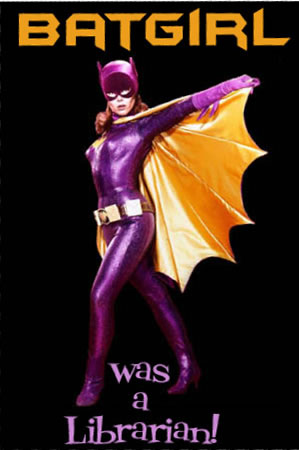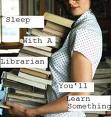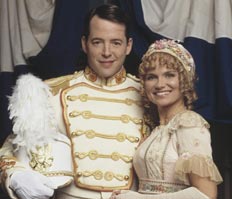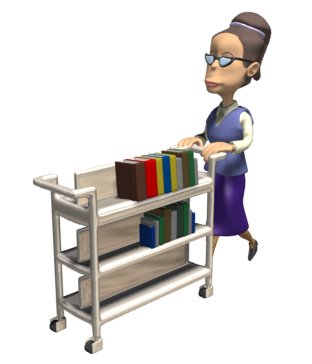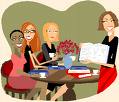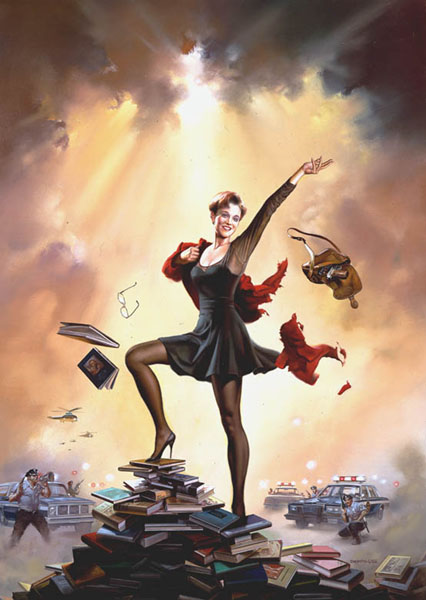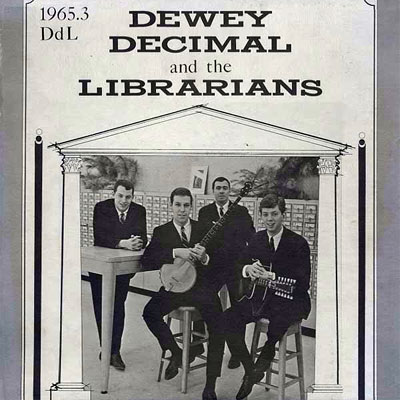Tevis, Ray and Brenda. (2005). The Image of Librarians in Cinema, 1917-1999. North
Carolina: McFarland & Company, Inc., Publishers.
This book examines the image of librarians in motion pictures from England and the United States, such as Adventure (1945), Desk Set (1957), The Music Man (1962), and A Simple Plan (1998). It “…offers critical commentary, and then examines its librarian character, from socioeconomic conditions and motivations to personal attributes (clothing, hair, age) and romantic entanglements to common props and plots” (Tevis, back cover).
Because movies have such a large impact on people’s lives, they contribute greatly to the image of librarians among the public. This book is an excellent source for studying how librarians are perceived in society because it offers commentary and criticism for movies that portray the stereotypical view of librarians.
Wednesday, December 3, 2008
Tuesday, December 2, 2008
WEBSITE ANNOTATIONS
Librarians: The Image and the Myth. Ed. Nancy Petrosino. 2005. 2 Oct. 2008
<http://stereotype-librarian.blogspot.com/>.
This website is a blog by Nancy Petrosino, an assistant librarian at a small school in central New York who is currently pursuing an MLS degree at the University at Buffalo. “This blog discusses the stereotypic image of librarians, and how that image has persisted over time” (Petrosino).
The blog is very interesting and contains numerous citations, articles and website links, such as “You Don’t Look Like a Librarian” and “Stereotypes of Men in Libraries.” There is also a list of books about the image of librarians, like The Librarian from the Black Lagoon by Mike Thaler, and The Image of Librarians in Cinema, 1917-1999 by Ray and Brenda Tevis. This website is very informative and presents creative, helpful resources about the changing image of librarians in society.
Image of Librarians. The Internet Public Library. 2008. 2 Oct. 2008
<http://www.ipl.org/div/subject/browse/hum45.10.50/>.
This website is the Internet Public Library’s listing of helpful links and resources about the image of librarians. At this website, you can search for various subjects and collections, and even contact an IPL librarian on the web.
The IPL offers links to articles like “The Librarian Stereotype and the Movies,” published in The Journal of Academic Media Librarianship, and websites like The Lipstick Librarian, www.lipsticklibrarian.com. The format of this website is easy to navigate and offers many resources to look at. It offers many diverse resources about the image of librarians, which is beneficial because it’s important to have a large selection of research to refer to.
<http://stereotype-librarian.blogspot.com/>.
This website is a blog by Nancy Petrosino, an assistant librarian at a small school in central New York who is currently pursuing an MLS degree at the University at Buffalo. “This blog discusses the stereotypic image of librarians, and how that image has persisted over time” (Petrosino).
The blog is very interesting and contains numerous citations, articles and website links, such as “You Don’t Look Like a Librarian” and “Stereotypes of Men in Libraries.” There is also a list of books about the image of librarians, like The Librarian from the Black Lagoon by Mike Thaler, and The Image of Librarians in Cinema, 1917-1999 by Ray and Brenda Tevis. This website is very informative and presents creative, helpful resources about the changing image of librarians in society.
Image of Librarians. The Internet Public Library. 2008. 2 Oct. 2008
<http://www.ipl.org/div/subject/browse/hum45.10.50/>.
This website is the Internet Public Library’s listing of helpful links and resources about the image of librarians. At this website, you can search for various subjects and collections, and even contact an IPL librarian on the web.
The IPL offers links to articles like “The Librarian Stereotype and the Movies,” published in The Journal of Academic Media Librarianship, and websites like The Lipstick Librarian, www.lipsticklibrarian.com. The format of this website is easy to navigate and offers many resources to look at. It offers many diverse resources about the image of librarians, which is beneficial because it’s important to have a large selection of research to refer to.
ARTICLE ANNOTATION 6
Fialkoff, Francine. “The Image Thing.” Library Journal. 132.3 (2007): 8.
This article mentions the public impression of librarians as dowdy and unsociable. Fialkoff talks about the professional and social image of librarians and how appearance has a great deal to do with how librarians are viewed by society. This piece examines the fact that many librarians do not fit the stereotypical image of the profession.
In stating, “We assume the rest of the world sees librarians as we do, and we're inevitably disappointed when that's not so,” this article illustrates the feeling of many librarians in society. Fialkoff makes several interesting points about the image of librarians and how we are trying to fight the stereotype through our own physical appearance, professional goals and societal interactions.
This article mentions the public impression of librarians as dowdy and unsociable. Fialkoff talks about the professional and social image of librarians and how appearance has a great deal to do with how librarians are viewed by society. This piece examines the fact that many librarians do not fit the stereotypical image of the profession.
In stating, “We assume the rest of the world sees librarians as we do, and we're inevitably disappointed when that's not so,” this article illustrates the feeling of many librarians in society. Fialkoff makes several interesting points about the image of librarians and how we are trying to fight the stereotype through our own physical appearance, professional goals and societal interactions.
ARTICLE ANNOTATION 5
Morrisey, Locke J. and Case, Donald O. “There Goes My Image: The Perception of Male
Librarians by Colleague, Student, and Self.” College & Research Libraries. 49.5
(1988): 453-464.
Morrisey and Case present a study of undergraduate and graduate students as well as university librarians concerning perceptions of male librarians. The article states, “In general, the members of the male library group felt the male librarian is looked on negatively when he actually was looked on quite positively by the other respondents.”
This commentary is very useful because it contains a survey of library students and professional librarians from a variety of backgrounds. The authors show the misconceptions and image-consciousness that many people experience, and illustrate the perceptions of librarians themselves. The article offers a great deal of interesting data about male librarians in the field of library science.
Librarians by Colleague, Student, and Self.” College & Research Libraries. 49.5
(1988): 453-464.
Morrisey and Case present a study of undergraduate and graduate students as well as university librarians concerning perceptions of male librarians. The article states, “In general, the members of the male library group felt the male librarian is looked on negatively when he actually was looked on quite positively by the other respondents.”
This commentary is very useful because it contains a survey of library students and professional librarians from a variety of backgrounds. The authors show the misconceptions and image-consciousness that many people experience, and illustrate the perceptions of librarians themselves. The article offers a great deal of interesting data about male librarians in the field of library science.
ARTICLE ANNOTATION 4
Josey, E.J. “The Role of the Negro Librarian in the Great Society.” The Quarterly
Review of Higher Education Among Negroes. Vol. 34 (1966): pp 46-51.
This article explores how African-American librarians were seen by their communities as well as society. Josey discusses the image, duties and expectations of black librarians in the United States, focusing not only on race but opportunities and limitations. He also mentions how blacks could improve their abilities and image within the library profession.
Josey’s article is a valuable illustration of the role of blacks in society during this time. His discussion includes how black librarians are viewed by both the black and white communities. This article is an excellent way to discover how race affected the library profession and the image of black librarians during this point in history.
Review of Higher Education Among Negroes. Vol. 34 (1966): pp 46-51.
This article explores how African-American librarians were seen by their communities as well as society. Josey discusses the image, duties and expectations of black librarians in the United States, focusing not only on race but opportunities and limitations. He also mentions how blacks could improve their abilities and image within the library profession.
Josey’s article is a valuable illustration of the role of blacks in society during this time. His discussion includes how black librarians are viewed by both the black and white communities. This article is an excellent way to discover how race affected the library profession and the image of black librarians during this point in history.
ARTICLE ANNOTATION 3
Christ, R W. “What Lies Ahead: how librarians, as individuals, through cooperative
effort and a set of standards, can aid in the solution of the many problems facing
the world.” Special Libraries. Vol.36 (December 1945): 470-474.
This article mainly discusses the abilities of librarians to aid in the improvement of world problems such as education and information availability and access. Christ offers a broad perspective of different ways that librarians can help development in communities and the world as a whole.
The document is very interesting because it shows librarians as capable of affecting great changes in the world. It encourages cooperative undertaking of improvements to information availability and connections with the community. Librarians are assigned vast opportunities and authority and, therefore, are seen as responsible, intelligent and influential members of society and the professional world.
effort and a set of standards, can aid in the solution of the many problems facing
the world.” Special Libraries. Vol.36 (December 1945): 470-474.
This article mainly discusses the abilities of librarians to aid in the improvement of world problems such as education and information availability and access. Christ offers a broad perspective of different ways that librarians can help development in communities and the world as a whole.
The document is very interesting because it shows librarians as capable of affecting great changes in the world. It encourages cooperative undertaking of improvements to information availability and connections with the community. Librarians are assigned vast opportunities and authority and, therefore, are seen as responsible, intelligent and influential members of society and the professional world.
ARTICLE ANNOTATION 2
“Librarians in Chicago.” Time Magazine. 30 Oct. 1933. Time.com, Time Inc. 2008. 18
Oct. 2008.
This article discusses a conference that took place in Chicago with the American Library Association and the International Federation of Library Associations. The document mentions a library service survey, prison libraries, book circulation and how librarians have impacted communities through their activities.
“Librarians in Chicago” is not very long, but contains useful information about the interests and activities of librarians during this time in history. There are various comments that show the image of librarians during the 1930s, such as how the attendees “tiptoed” around the conference, that “librarians like to guide the young in reading,” and that they “scanned with interest a space-saving bound volume of the New York Times.” This is a very useful source for discovering librarians’ interests and images for this time period.
Oct. 2008.
This article discusses a conference that took place in Chicago with the American Library Association and the International Federation of Library Associations. The document mentions a library service survey, prison libraries, book circulation and how librarians have impacted communities through their activities.
“Librarians in Chicago” is not very long, but contains useful information about the interests and activities of librarians during this time in history. There are various comments that show the image of librarians during the 1930s, such as how the attendees “tiptoed” around the conference, that “librarians like to guide the young in reading,” and that they “scanned with interest a space-saving bound volume of the New York Times.” This is a very useful source for discovering librarians’ interests and images for this time period.
Subscribe to:
Posts (Atom)


